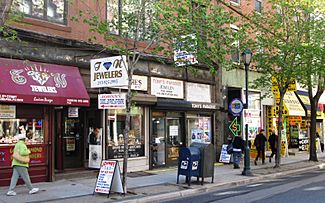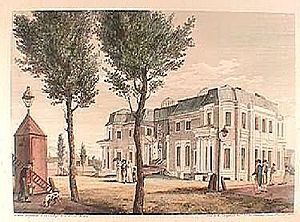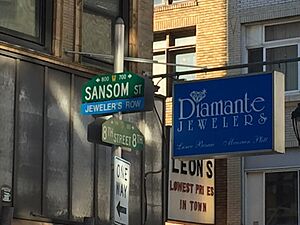Jewelers' Row, Philadelphia facts for kids
Quick facts for kids
Jewelers' Row
|
|
|---|---|

Jewelers' Row: The west side of S. 8th Street between Sansom and Chestnut Streets looking north.
|
|
| Country | |
| State | Pennsylvania |
| County | Philadelphia |
| City | Philadelphia |
| Area code(s) | 215, 267 and 445 |
Jewelers' Row is a special neighborhood in Philadelphia, Pennsylvania, USA. It's famous for having over 300 shops, sellers, and skilled artists who make and sell jewelry. You can find it in the Center City area, mainly on Sansom Street and Eighth Street.
This historic area is the oldest place in America known for diamonds. It's also the second largest diamond district, right after New York City's. Many of the jewelry stores, workshops, and appraisal businesses here have been run by the same families for five generations!
Contents
A Glimpse into Jewelers' Row's Past
How Jewelers' Row Began
Jewelers' Row, also known as Carstairs Row, was designed a long time ago, around 1799 to 1820. It was built by Thomas Carstairs for a developer named William Sansom. This was one of the first times in the United States that many houses were built at once to be sold. It also helped introduce the idea of "row houses" to America.
Carstairs Row was built on land that used to have an unfinished mansion called "Morris' Folly." This mansion was designed by Pierre Charles L'Enfant for Robert Morris.
From Mansion to Row Houses
William Sansom bought the land and Robert Morris's unfinished house. He then created a new street, Sansom Street, right through the property. Carstairs bought the south side of Sansom Street and built 22 similar-looking homes. Before this, houses were usually built one by one, not in long rows. This is different from places like Elfreth's Alley, where all the houses look unique.
The way William Penn planned Philadelphia, with its grid pattern of streets, really helped shape the idea of row houses. This block of row houses is an important example of Philadelphia's building and development history.
Attracting New Residents
Sansom built these homes when they were still on the edge of Philadelphia. To get people to move there, he paid to pave Sansom Street himself. He then hired Benjamin Latrobe to design another row of houses nearby. A key feature of these buildings was their flat, simple fronts, which made them perfect for turning into shops later on.
Protecting History: A Modern Challenge
In 2016, a company planned to build a tall, 29-story building of apartments on Sansom Street. This would have meant tearing down five older buildings. Many people in Philadelphia wanted to protect these historic buildings. Two of them were even nominated to be listed as historic places.
This plan caused a lot of disagreement. Signs against the project appeared in windows, and many people spoke out. They wanted to save the unique look and history of Jewelers' Row.
Changes Through the Years
Over time, in the late 1800s and early 1900s, most of the original row houses changed. Only a few, like 700, 730, and 732 Sansom, still look much like they did originally. For example, 710 Sansom was built in 1870. It's a three-story building with stone details. Its Victorian style is typical of the buildings that became the center for jewelry and diamond businesses in the mid-1800s.
Another building, 722 Sansom, was built in the 1860s. It was updated in the early 1900s when steel became more common. And 724 Sansom, built in 1875, has a special cast iron first floor.
After these homes were sold for businesses, several artists who engraved plates for books moved in. At 732 Sansom, the engraver for the famous writer Edgar Allan Poe lived and worked. Poe himself even ate dinner in that house several times!



